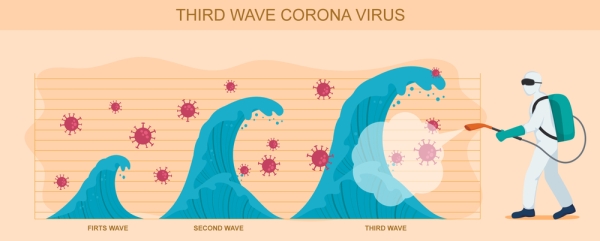A user-friendly, web based model simulator helped India to predict the third wave: ICMR
Last year, shortly after the second Covid-19 wave, the Indian Council of Medical Science (ICMR) developed a model called CHROMIC (Collaborative Health Research
- by B2B Desk 2022-05-13 20:51:55
The implementation of a user-friendly, web-based modelling simulator helped government officials and scientists estimate the threat of the third wave and the public health response, according to a report published in the British Medical Journal. The implementation of such initiatives in pandemic preparedness in the Global South is recommended by India's main medical research agency, based on experience.
.png)
Last year, shortly after the second Covid-19 wave, the Indian Council of Medical Science (ICMR) developed a model called CHROMIC (Collaborative Health Research on Modelling-Indian Council of Medical Research) for policymakers to interact directly with a model in collaboration with the union health ministry and Imperial College in London. They profited from the stimulator because of locally accessible data and a thorough awareness of the healthcare system's demands.
"The CHROMIC model was used to assess if a third wave in India may be as severe as the second wave in June 2021, immediately following the decrease of the second wave. The findings suggested that such an event may occur if a novel variation develops with complete immunological escape from previously circulating variants, and lockdowns in specific geographic locations with high levels of transmission are abruptly released. The following appearance of the omicron wave confirmed the study's conclusions." Additional Director General, ICMR, Prof. (Dr) Samiran Panda. Planning public health responses to COVID-19 has benefited from mathematical modelling. As a result, the ICMR model or stimulator is very user-friendly and can be handled by health administrators and surveillance officers at the local level using smartphones and other smart devices.

"The simulator's goal was to develop forecasts for hospital capacity in the case of a third wave." Given the uncertainty about how a third wave might emerge at the time, the simulator allowed users to specify different mechanisms, such as the waning of immunity to previously circulating strains, the transmissibility of any future variant, the degree of immune escape of any such variant, and the release of local lockdowns and other restrictions in the face of emerging infections, according to Dr Panda. "Users might also input scenarios for increasing vaccination coverage and building health infrastructure in order to evaluate approaches to mitigate the effect of a future wave." Importantly, the simulator's resource needs results were substantially based on the nationwide COVID-19 Registry, making them anchored in local context and reality," he stated.
According to the ICMR, such preparations should be carried out during "peace time" and coordinated by bodies such as the WHO. It also adds that systematic processes are needed to monitor the use of models in decision-making, which will aid in giving modelling assistance to those local governments who could benefit the most.
.png)
Because the precise form of any pandemic is hard to foresee, the ICMR therefore encourages the use of adaptable modelling frameworks to respond quickly to future situations. Furthermore, modelling resources must be flexible quickly in order to respond as soon as a new disease appears, and modelling limits must be disclosed to end users clearly and consistently. As a result, modelling resources will need to be flexible quickly in order to respond as soon as a new disease appears. If one of the primary aims of modelling is to safeguard precious healthcare resources, according to the ICMR, this need is felt more more acutely in the Global South than elsewhere. "We hope that the lessons learned from this programme will enhance pandemic preparedness in other South and Southeast Asian nations," stated an ICRM scientist.
Also Read : Best Mutual Funds in India - To invest in 2022

POPULAR POSTS
Loan EMIs to Drop as RBI Slashes Repo Rate - Full MPC December 2025 Highlights
by Shan, 2025-12-05 11:49:44
Zoho Mail vs Gmail (2025): Which Email Platform Is Best for Businesses, Startups, and Students?
by Shan, 2025-10-09 12:17:26
PM Modi Launches GST Bachat Utsav: Lower Taxes, More Savings for Every Indian Household
by Shan, 2025-09-24 12:20:59
$100K H-1B Visa Fee Explained: Trump’s New Rule, Clarifications & Impact on Indian Tech Workers
by Shan, 2025-09-22 10:11:03
India-US Trade Deal Soon? Chief US Negotiator Arrives in Delhi as Talks Set to Begin Tomorrow
by Shan, 2025-09-15 11:54:28
Modi Meets Xi: Trump’s Tariffs, Strategic Autonomy, and the Future of Asia’s Power Balance
by Shan, 2025-09-03 06:40:06
Google Claims Gemini AI Uses Just ‘Five Drops of Water’ Per Prompt, Sparks Debate
by Shan, 2025-08-22 12:34:27
RECENTLY PUBLISHED

Pine Labs IPO 2025: Listing Date, Grey Market Premium, and Expert Outlook
- by Shan, 2025-11-05 09:57:07

The Agentic Revolution: Why Salesforce Is Betting Its Future on AI Agents
- by Shan, 2025-11-05 10:29:23

Top 10 Insurance Companies in India 2026: Life, Health, and General Insurance Leaders Explained
- by Shan, 2025-10-30 10:06:42

OpenAI Offers ChatGPT Go Free in India: What’s Behind This Big AI Giveaway?
- by Shan, 2025-10-28 12:19:11

Best Silver Investment Platforms for 2025: From CFDs to Digital Vaults Explained
- by Shan, 2025-10-23 12:22:46





 Subscribe now
Subscribe now 